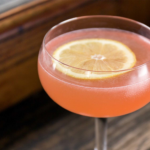 I am a child of the tropics and subtropics of India, and enjoy all its bountiful offerings of fruits with equal passion.
I am a child of the tropics and subtropics of India, and enjoy all its bountiful offerings of fruits with equal passion.
A few weeks ago, I managed to chance upon some decadently sweet seedless watermelon, and two fruits from the subtropics that I had never worked with before – passionfruit and, finger limes both sitting quietly on the end caps of the produce aisle in my grocery store.
I have loved watermelon for a long time and decided to experiment with the other two. Although bulky to store, I always prefer to purchase the whole watermelon instead of expensive and frankly suspicious pre-made chunks. I cut only as much as I need, plastic wrap the rest and set it cut side up in the fridge in a large bowl – so it does not tip over and the juices don’t run and get stale. Trust me, if you do this, your watermelon will stay fresh longer and you don’t have to eat the whole thing in one sitting (although I have been known to do that.)
Compared to the large watermelon, passionfruit is smaller than a baseball but perhaps the size of a large goose egg. The fruit is confusing to look at, if I didn’t tell them otherwise, my family would take one look at it and toss out the wrinkled ones. Blink and you will miss it in the grocery store. But this dinosaur egg-like, wrinkled fruit is exactly what you want for this drink.

I took five or six fruits home, and promptly proceeded to wait until they ripened, and ate the first few pretending I was trying to come up with ingenious ways to use them. But before I tell you how to use them, let me tell you the folklore around them. Did you know that these unusual beauties develop on a perennial vine by the same name, with rather fragrant and very complex looking flowers? In India, people refer to the flower a ‘Krishna Kamal’ or Krishna’s Lotus. The folklore behind the Krishna reference is such, Krishna is a mischievous Hindu deity who in his eternally mysterious ways conveys a love for each person he interacts with, and the flower represents his universe of different kinds of love. The flowers’ unique male and female floral parts are in the center, and represent Krishna and his eternal lover, Radha.
Their pairing, or romance represents the ideal, most passionate love. In contrast, the fringed collar at its base represents the many gopis’ or female cowherds who all are said to be entranced by Krishna, to believe that his attention towards them was a different kind love. These represent the adoring, idolizing kind of love, of infatuation, and they all dance in a circle around Krishna and Radha, recognizing that kind of a passionate love. As a whole, the flower represents the complex relationship between all of them, in this the dance of love. The folklore also goes to say that there was no truer love than the one between Radha and Krishna, all symbolically captured in this one flower. Perhaps it explains why this is called the Passion fruit.
The fruits of this lovely vine are extremely tasty, too. I learned quickly that if they sound hollow when you shake them, like maracas, and are utterly wrinkled on the outside, they are ready to eat. Rinse them out, hold each one over a clean bowl and pierce one side of the fruit at the ‘equator’ and proceed to cut it into two halves. The juices will spill out along with the seeds. You might have to scoop out some bits of it, only the yellow juices, yellow fibrous pulp and seeds are edible. You may choose to strain it all, and just use the juice or use it all. The juice is rather tart and refreshing with a golden yellow color that only nature can produce. The seeds are surprisingly crunchy.
Meanwhile, not to be overshadowed by its companion in the fruit basket, the finger limes taunted me with their little mysterious shapes, no more than about two inches in size. One look and they will remind you of baby pickles! They are actually native to the subtropics of Australia and many chefs are finding unique uses for them. Cut them open and they are filled with tiny caviar-like pearls that are sticky to the touch. When you slice them in half along the middle you can squeeze out the pearls quite easily. I wouldn’t do this before assembling your drink, as it is easiest to leave the pearls intact until you need them. They are crunchy to taste and give a burst of the unmistakable lemon juice when you bite into them.
When you start with tasty ingredients, the results undoubtedly are refreshingly delicious. So here is a wonderful cocktail I created with my trio of fruits and one of my favorite wines, a mildly sweet, sparkling Moscato d’Asti. Chilled watermelon gives it an unmistakable sweetness and the pearls of finger lime float around like bubbles that don’t burst surprising the taste buds with an unmistakable citrus tang. The seeds give it a nice crunch and give the look of having watermelon seeds, except they are not! Use your favorite chilled Moscato and you won’t go wrong. Here is to toasting to the loves in your life. And while you are busy toasting, I am going out looking for a sapling or four of the passionfruit vine for my garden.
Passionfruit Watermelon Cocktail
Makes: 2 servings
Ingredients
6 oz Moscato d’Asti, chilled
3-4 seedless watermelon balls or chunks per glass, chilled
Pearls of ½ finger lime
Juice of 1 passionfruit, strained, seeds optional
Directions
Fill half the glass with the chilled Moscato d’Asti. Add half the finger lime pearls in each and stir well so they are distributed well. Slowly lower in watermelon balls or chunks, and any of its juices and give it a light stir. At this time, the drink will take on a slightly pink color. Top up with the remaining Moscato. Add in the seeds if you have strained the juice and stir them in. For a ‘sunrise’ look on the drink, carefully transfer half of the passionfruit juice to the bottom of each prepared glass using a straw. Serve immediately.
 Nandita Godbole is an Atlanta-based freelancing food writer and an indie author of several cookbooks, whose readers reside in more than 30-countries globally. She most often writes about two of her favorite things: simple, flavorful, and holistic Indian food, and about family: the joys and complexities of delicate personal relationships. In the past 15 years, through her work, she shares the diverse culinary riches of India to uncover and rediscover intricate and unique layers of culture and identity. Nandita grew up in Bombay, in the city before it became Mumbai, India, which makes her easily nostalgic. Somewhere between her memories of her old home, her new home and kitchen, and her musings, she plays the roles of mom, chauffeur, chief do-it-all-er, and the absentminded gardener.
Nandita Godbole is an Atlanta-based freelancing food writer and an indie author of several cookbooks, whose readers reside in more than 30-countries globally. She most often writes about two of her favorite things: simple, flavorful, and holistic Indian food, and about family: the joys and complexities of delicate personal relationships. In the past 15 years, through her work, she shares the diverse culinary riches of India to uncover and rediscover intricate and unique layers of culture and identity. Nandita grew up in Bombay, in the city before it became Mumbai, India, which makes her easily nostalgic. Somewhere between her memories of her old home, her new home and kitchen, and her musings, she plays the roles of mom, chauffeur, chief do-it-all-er, and the absentminded gardener.



